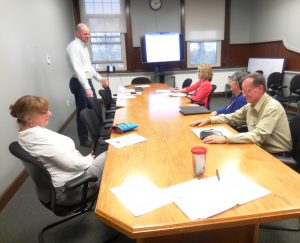
Peter J. Miller, Westfield director of community development, reviews the CDBG FY17 Action Plan at a public hearing in April. (Photo by Amy Porter)
WESTFIELD – Despite uncertainty leading up to the announcement of Community Development Block Grant funding for FY17, Peter J. Miller, director of community development said that Westfield will receive $347,000 for the fiscal year (July 1, 2017 through June 30, 2018), an increase of $24,000 over FY16.
“That’s good news. It’s helpful,” Miller said.
At the public comment meeting on the FY17 Action Plan, Miller had presented two scenarios; one based on level funding of $323,448, plus a contingency plan containing a 30% cut in the allocation to $226,413, per HUD (Housing and Urban Development) instructions. Part of the uncertainty was due to President Trump eliminating CDBG funding in his supplemental budget for FY17 and FY18.
Miller said the city can now fund everything on the Action Plan list. He submitted the plan, including public comments to HUD two weeks ago, and said funding usually is available within 45 days.
Among the items to be funded are $48,500 for public services, including grants ranging from $1,000 to $7,500 for the Boys & Girls Club, Kamp for Kids, DOMUS Hi-SET GED program, the Samaritan Inn, Westfield Food Pantry, Meals on Wheels, Westfield THOM Play Group, Westfield Council on Aging Companionship Program, Soup Kitchen, YMCA Transportation and New Beginnings.
Economic development is slated to receive $60,000. Miller said that businesses with five or less employees, or companies with greater than five employees but who could create a job for a lower-middle income employee are eligible in this category. The city plans to provide assistance to businesses locating in storefronts that have been vacant for six months or more, and plan to assist three businesses with the grant.
$120,000 will go to public infrastructure to be used for neighborhood improvements in the eligible lower-income districts, which are mostly surrounding the hospital and the riverfront areas. Miller said the program has had its biggest benefits in redoing sidewalks and curbing, and is looking at doing the same this year. He said he will work with engineering and public works to determine which streets to work on. Another $20,000 is slated for code enforcement activities.
$100,000 will go to home improvement for income-eligible homeowners. The deadline has passed to apply for this round of funding, which Miller anticipates will provide rehabilitation to eight homes.
$45,000 is also available for blight removal projects. Originally, Miller had anticipated using the funding to help the city to demolish the Romani Bowling Alley on Church Street; however, the City Council recently voted to transfer funds remaining at the end of the fiscal year in two departments for that purpose.
Miller said no determination has been made on where the blight removal funds might be spent. “It’s possible that we could seek to amend the plan to reallocate those funds to a different activity or we could identify some other blight removal project,” he said.
Miller said that now his department will begin work on the city’s CDBG plan for FY2018.

